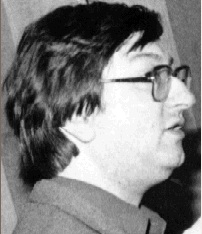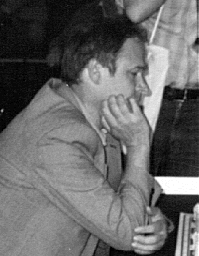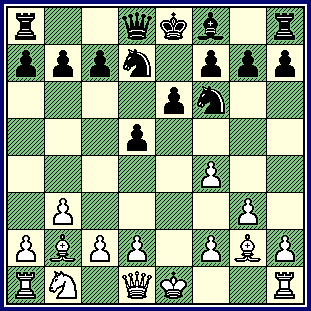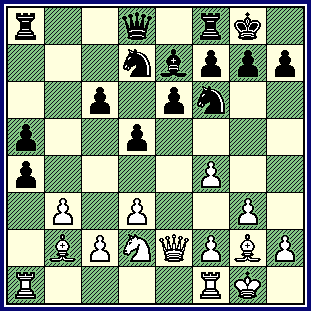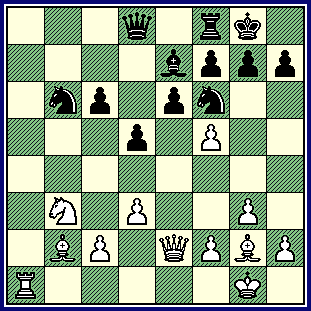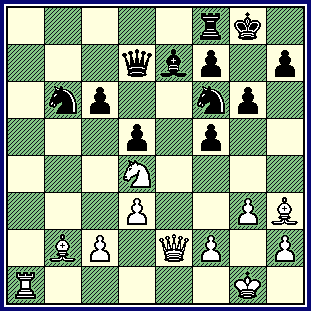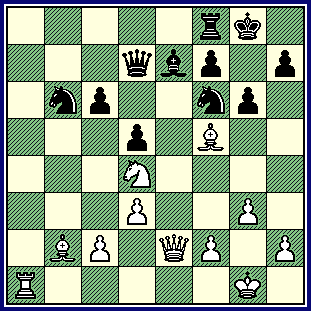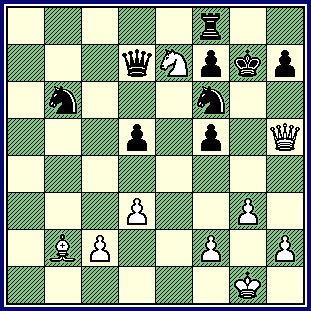All
the |
(Navigation bar
directly below.)
*******
© A.J. Goldsby, 2015.
(All rights reserved.)
****************
Click HERE
to see my
Chess Items.
****************
****************
Buy a book
from Amazon.com
(And help me out as well!)
****************
Click HERE
...
to see a list of the businesses that help to sponsor all of
my chess efforts.
GM R. Keene's Favorite Game |
Here is what GM Keene told me was his very best game of chess. (This one is not bad, either.)
Here is an explanation of the symbols that I more commonly use.
You can replay this game, if you have java-script enabled, here. (Not my site.)
Today, both of these players are a GM! I left the titles off, not because I wished to insult anyone, but simply because I could not be sure when {the exact date} each player was awarded their individual titles. (For the sake of accuracy.) Raymond
Keene
(2445) - Vlatko
Kovacevic (2485)
|
|
|
I was fortunate enough to be in contact (via e-mail) with GM R. Keene in the second half of the year, 2005.
I asked him for a favor ...
and he was kind enough to tell me which master-level encounter that he thought was his best, or at least
his favorite (all-time) effort.
This game was played - I believe - in a crucial last round fight for first place in this tournament.
*** *** *** *** *** *** *** *** *** *** *** *** *** *** *** *** *** *** *** *** *** *** *** *** ***
(The ratings are probably those of FIDE, and closely correspond to those given in the FIDE year-book for this period. I did not assign these ratings, they were already a part of the game when I downloaded it directly from the ChessBase website.)
1.Nf3,
The Reti, R. Keene is not adverse to playing in the hyper-modern fashion.
Of course, the most popular (more commonly played) opening moves involve a thrust with one of the center Pawns for White. (1.e4, or 1.d4.)
I should point out that there is ABSOLUTELY NOTHING WRONG with this move, whether you open with the classical openings or whether you prefer to start the game with a hyper-modern opening ... ... ... its all just a matter of taste.
1...d5;
A standard, "book" reply; Black also immediately grabs space and
stakes a claim to vital central squares.
[ Also possible was
1...Nf6!?;
(symmetry)
trying to maintain a fluid position and keep White
guessing. ]
2.b3!?,
(The Nimzovich - Larsen Variation.)
White decides to fianchetto his QB.
Thanks to the games of GM Bent Larsen, this was fashionable at the time. (Ray was also deeply studying the games of a great hyper-modern, and this line was a pet variation of A. Nimzovich; a creative chess player who had many innovative and original chess ideas.)
As nearly everyone knows, GM R. Keene has written many chess books. Two of which are the definitive book on the style and games of Nimzovich, and also a very good, in-depth book on this opening as well.
[ The book line would be:
(>/=)
2.c4 c6; 3.b3 Nf6;
4.g3 Bg4!; 5.Bg2 e6;
6.0-0 Nbd7; 7.Bb2 Bd6;
8.d3 0-0; 9.Nbd2 a5;
The end of the column.
10.a3 Qe7; 11.Qc2 e5;
12.e4!? dxe4; 13.dxe4 Bc5; 14.h3,
"~" (Maybe "+/=")
when White has a slight edge, according to the authors of MCO.
(Fritz awards a slight edge to Black, I call the position unclear here.)
GM Johan Hjartarsson (2590) - GM Hannes Stefansson (2530);
TV Game
(rapid, R3) / Reykjavik, Iceland; 1995. (1-0)
{35 moves.}
[ Please see MCO-14, page # 706;
column # 06, and all associated notes
for this particular column. Esp. # (p.). ]
]
2...Bg4!?;
(hmmm)
Black gets his Bishop out ... so it does not become trapped behind his pawn structure.
However, I don't like this move, and prefer to maintain my Bishops. (Fritz likes this
move, and even awards Black a slight edge here - which shows why computers are not yet to be 100% trusted in all areas of the game.)
[ Maybe a little better was:
(>/=) 2...Nf6; 3.Bb2
e6; 4.c4 Be7; 5.g3 0-0; 6.Bg2 c5;
7.0-0 Nc6; 8.e3,
"~" with complicated play.
A good example of this position would be:
GM R. Vaganian - GM M. Tal; /
ICT / Masters
Yerevan, U.S.S.R;
Yerevan, U.S.S.R; (R6);
1980.
{White might have had a slight edge, but Black triumphed
after forty very tense & difficult moves.}
]
3.Bb2 Nd7;
4.g3 Bxf3!?;
Black decides to 'ruin' White's Pawn structure while he still has the chance. However, this move opens the e-file for White, loses the Bishop-pair, and once White's f-pawn reaches f4, will allow White to dominate the center.
Keene indicates that Black was playing for a win with this daring move. I should also point out that when these same two opponents met approximately two years later, Kovacevic did NOT swap on f3, and made a relatively easy draw. (Rovinj/Zagreb, 1975.)
[ Probably less dangerous was:
(>/=)
4...Ngf6; 5.Bg2 e6; "~" etc.
A. Minasian - Z. Hracek;
(R1) / Yerevan,
RUS; 1996. {Black eventually won.} ]
5.exf3
Ngf6;
A normal developing move.
(Black protects d5, controls e4, and also gets a piece off the back row and into the
fracas.)
[ The continuation of:
5...e5!?; 6.Qe2 Qe7; 7.Bh3 Ngf6; 8.0-0, "+/="
(An edge for White.)
leads to wild complications ... that are not totally unfavorable to White.
]
Now White expends a tempo to control the e5-square, and further enhance his control of all the dark squares on the long diagonal.
6.f4! e6;
7.Bg2, {See
the diagram given, just below here.}
To me, this is entirely correct.
(White develops a piece which hits a very crucial diagonal ... and keeps all of his options
open. Keene awards this move the dubious appellation, {?!}; however I cannot agree with
this rather harsh evaluation.)
************************************************************************
|
|
************************************************************************
r2qkb1r/pppn1ppp/4pn2/3p4/5P2/1P4P1/PBPP1PBP/RN1QK2R b
Bh3 is only a better move if it is one-hundred per cent certain that White should play for f5, or that this is the only way for the first player to emerge from the opening with any type of {real} edge. To me, it is just too early to be making that type of determination. And thanks to the fact Black has already (willingly) surrendered the Bishop-pair, I believe that White can look forward to both the middle-game and the ending ... with full confidence that his chances are as good as - if not better than - Black's ... at least, from the current position that we have on the chessboard.
[ (>/=) 7.Bh3!?, "+/=" ("/\") '!' - GM Ray Keene ]
7...Be7;
8.0-0 0-0; 9.d3 a5; 10.a4!,
White keeps his opponent from gaining any more space on the Queenside here.
[ (</=) 10.Nd2 a4; "<=>" ]
10...c6;
11.Nd2!,
An excellent move.
As a master, this move is somewhat obvious. (The Knight is already thinking about the e5-square as an awesome outpost.) However, after showing this game at the chess club (and on the Internet) a few times, it became very apparent that the amateur will NOT play this move as a matter of course! (Most want to play Nc3, or when told that this move is not the most accurate, then they will try Re1 or h3.)
[ 11.h3, - Fritz 7.0 ]
11...b5!?;
Black decides that his natural theater of play will be the Q-side. At first, I thought that this concept was doubtful,
until I realized that Black's opening has not left him with many viable
alternatives.
12.Qe2 bxa4?!;
(Maybe - '?')
{See the diagram given, just below
here.}
Black decides to open lines, but the results of this decision leaves him with an inferior game.
************************************************************************
|
|
************************************************************************
r2q1rk1/3nbppp/2p1pn2/p2p4/p4P2/1P1P2P1/1BPNQPBP/R4RK1 w
Better was
...Rb8; or ...b4; when Black is not substantially worse.
('?' - GM Raymond Keene)
13.Rxa4 Nb6;
14.Ra2 a4;
Having said "A" ... Black now naturally follows up with "B" here.
(If the second party delays this idea, White will pile up on Black's now weakened a-pawn.)
15.Rfa1 axb3;
16.Rxa8 Nxa8; 17.Nxb3 Nb6;
Black feels the need to resurrect the dead horse on a8 as soon as possible ... to me, this is a completely natural response for a master.
(17...c5; was also an idea here.)
Now White rains tactical shots down on Black - a whole series of hammer blows from this position.
18.f5!!,
{See the diagram given, just below here.}
At first, it would be easy to say, especially with the benefit of hindsight, that this was an obvious thrust for White in this position.
************************************************************************
|
|
************************************************************************
3q1rk1/4bppp/1np1pn2/3p1P2/8/1N1P2P1/1BP1QPBP/R5K1 b
However, when I ran this game by about a dozen of the more popular chess programs ... I was surprised to find that most did not choose this particular play for White. (I saw everything from 18.h3, 18.c4, 18.Qe5, and also 18.Ra7! for White, here.) I also tested this game on several members of our local club, none of them chose f5 for White here, either.
Keene's move is the most thematic, as Black's Pawn shell is immediately subjected to unbearable stress. Of course, to make this concept work, White must be willing to sacrifice at least a Pawn. (And maybe a whole lot more!)
[ A strong and obvious play is:
(</=)
18.Ra7! Nbd7; 19.Be5 Re8;
20.Bc7 Qc8;
21.h3 Nc5; 22.Nd2,
"+/=" with some advantage.
- Analysis, Fritz 8.0 ]
18...exf5;
([]?) 19.Nd4! Qd7;
A few have criticized this play ... to me, it looks like a routine chess move and is also the first choice of Fritz 8.0. (Black has really big problems if he allows the Knight to capture on the f5-square.)
[
(</=)
19...Re8!?;
(Probably inferior.)
20.Nxf5 Nbd7; 21.Qd2,
"+/=" ('±')
(and) White is clearly better.
****************************************************************************************
Of course not: </= 19...c5??; 20.Nc6, "+/-" and Black loses a piece. ]
20.Bh3!,
("Pin & win." - Reinfeld)
(Maybe - '!!')
Not at all an obvious move ... I showed this position to one player who is rated over 2000. (USCF) [He thought for close to 10 minutes.] First he chose 20.Nxc6!, and then 20.Qe5!?, (when he was informed that his first choice was not the most accurate move), I should
also point out that I tested this position on several chess engines, and none of those chose 20.Bh3! either.
This move looks rather pointless ... (after ...g6)
...
unless you see the follow-up to this Bishop play.
[ (</=) 20.Nxc6!, "+/=" - Fritz 8.0
********************************************************************
Other engines choose the following continuation here:
(</=)
20.Qe5!? Ng4;
21.Qxf5,
"+/=" {Diag?}
which also leads to an edge for White as well.
]
20...g6!?;
(hmmm) {See
the diagram given, just below here.}
This looks like a natural move, but is probably "less-than-best" ...
('?!') as Fritz discovers a much better defense for Black.
************************************************************************
|
|
************************************************************************
5rk1/3qbp1p/1np2np1/3p1p2/3N4/3P2PB/1BP1QP1P/R5K1 w
Black's position looks solid here, but a series of well thought out explosions rock the ramparts of Kovacevic's defensive fortress.
[ Probably an improvement was:
>/= 20...Re8!;
21.Nxf5 Ba3!!;
22.Qd2, (Box?) Probably best.
( But not </= 22.Nh6+?! gxh6; 23.Bxd7? Rxe2; 24.Bxf6
Nxd7;
("-/+") when Black has an extra piece.
)
22...Bxb2; 23.Nh6+ gxh6;
24.Bxd7 Nbxd7; 25.Ra6,
"+/=" ('±')
25...Bd4;
"<=>" with some chances to defend.
(Black has three
minor pieces for the Queen here, it will take some extremely accurate
play for White to bring home the full point.)
]
21.Bxf5!!,
(Maybe - '!!!') {See
the diagram given, just below here.}
An astounding shot, to say the least. I took this game to chess club and showed it to a few people, not one person chose this move.
(Not even Fritz chooses this play - after five
minutes, the machine wants to play 21.Qe3!, which leads to a virulent attack on the
dark squares.) Keene's play is much superior to anything the box finds ... and rips Black's Kingside to shreds.
************************************************************************
|
|
************************************************************************
5rk1/3qbp1p/1np2np1/3p1B2/3N4/3P2P1/1BP1QP1P/R5K1 b
(future) GM R. Keene's move is a fantastic shot - and looks like it could have been played by Mikhail Tal, Bobby Fischer ... or even Garry Kasparov. (I can offer no higher praise.)
[
Black may have expected:
</= 21.Nxc6! Qxc6;
22.Qxe7,
"+/=" (Maybe -
'±')
when White is better, but the win is not immediately in sight.
*****************************************************************************************
Fritz 8.0
chooses:
(</=)
21.Qe3!? Qd6; 22.Ra6 c5;
23.Nb5 Qd8; 24.Bxf6 Bxf6;
25.Qxc5,
"+/=" (with a
definite advantage for White here);
and while this allows the first player the upper hand, it is
grossly
weaker than the smashingly brilliant coup played by Raymond Keene.
]
21...gxf5;
Looks bad - but Fritz confirms it was already too late for any half measures by Kovacevic.
(I.e., 21...Qc7?; 22.Nxc6!)
22.Ra7!,
(Surprise!
Maybe - '!!')
This looks impossible - at least to the average player - until you see the fork looming on the c6-square. (Most of the guys at the club wanted to play 22.Qe5, in this position.) This position shows the difference between the way a human thinks and the way a computer program 'looks' at a position; most humans don't even consider this move, while a silicon-based intelligence finds this amazing R-move instantly.
Normally, a piece sacrifice ............
is not immediately followed up by the sacrifice of a whole Rook ...
('!!' - GM Raymond Keene)
[ Possible was:
22.Qe5!?,
(with a Q+B battery on the long diagonal);
but it is much less effective than what actually occurs in the game.
]
22...Qxa7[];
Black has no choice here.
[ </= 22...Qd8?; 23.Nxf5!, "+/-" ]
23.Nxc6 Qd7!?;
hmmm
('?')
This looks like a 'normal' human response.
(But it is quite possibly an error here for V. Kovacevic.)
The machine 'thinks' that Black has to give up the Queen here ... but before playing this way, I think that Black might have chosen to resign.
As Keene also points out, often times when you are the defender, you fall victim to what Tarrasch referred to as "sacrificial shock." (Emotions cloud your thinking, and you do not find the best defense.) And one further point ... apparently even if Black had found the better defense here, this was no guarantee that he could have drawn the game.
[ Black probably had to play:
(>/=)
23...Ba3!;
('[]')
{The only real try for Black.}
24.Nxa7 Bxb2;
25.c4,
"+/=" ('±')
with a little play.
(White is much better here, but a clear win is a long
way off. See GM R.
Keene's analysis on the CG
website
for more on this line.)
****************************************************************************
Of course not:
</= 23...Qa2?;
24.Nxe7+ Kg7;
25.Nxf5+ Kg6; 26.Ne7+ Kh6;
According to Fritz, this move is completely forced.
(</= 26...Kg7?; 27.Qg4+, etc.)
27.Qe3+ Kh5; 28.Qe5+, "+/-" and mate in two. ]
24.Nxe7+
Kg7; 25.Qh5!, {See the
diagram, just below.}
A beautiful and unexpected shot, the main point is that the line of:
25...Qxe7; 26.Qg5+ and 27.Bxf6, "+/-" is completely hopeless for Black.
************************************************************************
|
|
************************************************************************
5r2/3qNpkp/1n3n2/3p1p1Q/8/3P2P1/1BP2P1P/6K1 b
White -
Kg1,Qh5,Ne7,Bb2,Pc2,d3,f2,g3,h2/ Black -
Kg7,Qd7,Nb6,f6,Rf8,Pd5,f5,f7,h7.
(Black Resigns, 1-0.)
A fantastic game by Keene, who manages to not only win brilliantly, but also sacks quite a number of pieces as well. Having studied this game in depth, it is easy to see why such a brilliant "partie" is the favorite effort of GM Ray Keene!
[ Instead
Fritz 8.0 prefers:
(>/=) 25.Qe5! d4!?;
26.Nxf5+, etc. "+/-"
(With a winning attack.) ]
Copyright (c) A.J. Goldsby, 2005. All rights reserved.
1 - 0
This game was not created to examine this opening in depth.
There are literally dozens of reference books, (MCO, ECO, NCO, etc.); that you could consult if you have any questions about the material presented here ... especially as concerns the opening. Also - several books on this specific opening, (1.b3); have been written, you could consult any one of these as well.
*******
I used the excellent program, ChessBase 9.0 to prepare the notes and game analysis. I used the program, Chess Captor 2.25 to prepare the diagrams. I used "FrontPage" to prepare and polish the HTML for my website.
Apparently there was/is some confusion over the second player's name, you can read all about it in the comments/kibitzing on this page.
I just recently (January, 2006) purchased a new chess book, here is what it says on the back cover: "Vlatko Kovacevic is a grandmaster from Croatia, and arguably the world's leading authority on the London System. However, he is probably best known for a convincing victory against Bobby Fischer in 1970. He has represented Croatia, and previously Yugoslavia, in many international team events." (This info can also be found on publisher's web page.) Buy.
See the volume: "Win with the London System." By V. Kovacevic and S. Johnsen.
Copyright (©) 2005. Published by Gambit books. ISBN # 1-904600-35-2
If you are interested, there is a list on this page ... of all of GM Ray Keene's favorite games. (Most have notes.)
This
page was created in September or October of 2005.
The analysis was posted here (on this page) around November 20th, 2005.
Final
format completed on: Saturday; November 26th, 2005.
This page was last edited or modified on: Wednesday, May 06, 2015 04:11 PM
.
[Home] [Site Map] [Favorite games of well-known players]
Copyright (c) A.J. Goldsby, 2015. All rights reserved.
